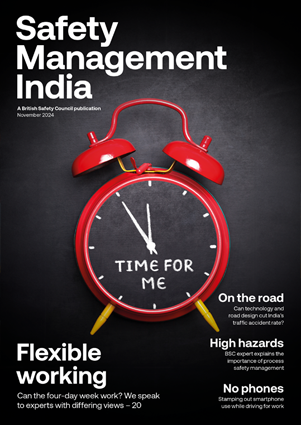Women workers recently hit the headlines for forcing electronics giant Foxconn to improve working conditions at its iPhone factory in Tamil Nadu, throwing light on the poor employment practices of some of the country’s biggest companies.
Features
Fighting for better conditions
In December 2021, women workers who assemble iPhones at a manufacturing facility run by Apple supplier Foxconn in Sriperumbudur on the outskirts of Chennai in Tamil Nadu, staged a rare protest that shut down the plant where 17,000 people were employed.
The majority are migrant contract workers employed through third-party contractors or agencies, and lack contracts, identity cards or any proof that they are employed by Foxconn.
For their pay checks, the women also had to endure crowded dormitories, toilets without running water and food sometimes crawling with worms, it was alleged. But when over 250 workers fell ill and had to be hospitalised due to food poisoning, the simmering anger of many of the workers over poor working and living conditions and exploitation finally boiled over.
Around 4,000 women took to the streets, alleging that food at Foxconn’s dormitories was stale and the toilets were unhygienic and inadequate, without running water. Worse, 20-40 workers were reportedly being lodged in rooms that lacked proper ventilation, and were only designed to accommodate a maximum of 10 people.
 Photograph: iStock/Kachura Oleg
Photograph: iStock/Kachura Oleg
The protests exposed poor labour conditions at the Foxconn facility, and came at a time when Apple is ramping up production of its iPhone 13 and shareholders are pushing the technology giant to provide greater transparency about labour conditions at its suppliers around the globe.
Apple demands ‘rapid action’ over working conditions
Following the protests and plant shut-down, Apple put its contractor Foxconn on probation, demanding rapid action.
In a statement released shortly after the controversy began, Apple said: “We will ensure our strict standards are met before the facility reopens. We will continue to monitor conditions closely.”
The state government also told Foxconn to improve amenities at its hostels at the Sriperumbudur plant and to obtain the collector’s approval before reopening.
Foxconn apologised for the incident. Commenting on the controversy, Apoorva Kaiwar, regional secretary of the IndustriALL global union, said: “The young women at the factory were pushed to protest as a result of the absolutely inhuman working conditions in the Foxconn plant, as well as the living conditions in the dormitories. It is imperative that trade unions have access to these young workers so that they can unionise and improve their working and living conditions.”
Meanwhile, women’s rights activist and Indian ambassador for women’s entrepreneurship Madhu Saran said: “Basic infrastructure for women in workplaces is much needed, like toilets, canteens, dorms. There needs to be regular monitoring by the government, labour and law departments.”
Observers point out that the poor living conditions at Foxconn dormitories have caused huge embarrassment to Apple as well as Foxconn.
Foxconn reopened the Sriperumbudur plant on 12 January 2022 after assuring Apple and the state government that it had taken corrective actions at its hostels. The plant resumed operations with around 400 workers and 2,000 technical staff.
The Economic Times reported that Foxconn was granted permission by the state government to house workers in two of the 17 hostels the Taiwanese company operates at the site.
Urban Company in the spotlight
The closure of the Foxconn plant – and the resulting moves to improve conditions at the plant – is a victory for ordinary women workers who have brought their plight to the world’s attention. However, another group of protesting female workers who are in the spotlight are from India’s largest home services provider, Urban Company.
In October, roughly 100 women agitated outside the start-up’s office in Gurgaon to protest against “low wages, high commissions and poor safety conditions”.
The company first vowed to boot the women workers off the platform – which provides customers with services at home, such as beauty treatments, cleaning and repairs – but soon announced a slew of policy changes that included lowering partner commissions, reducing penalties and setting up an SOS helpline for women.
However, in December – when there was another protest by women workers from the company’s beauty wing against the company’s newly introduced policy changes, which the workers claim will adversely affect their earnings and working hours – the start-up took the extreme step of suing some of its workers that it refers to as “partners”.
The unicorn start-up filed a lawsuit in the Gurugram district court against its gig workers for protesting against the company’s alleged “unfair labour practices”.
Urban Company’s lawsuit against its workers is unusual, said Antonio Casilli, a professor of sociology at the Polytechnic Institute of Paris, on Twitter.
“Gig workers suing platforms to enforce labour laws – this happens more and more often. But for a platform to sue its gig workers who strike to have labour law enforced – that’s a first,” he said, noting that the defendants are all women.
Seema Singh, a worker on the platform who has been associated with Urban Company for the past four years and is mentioned in the lawsuit, stated that the company is implementing a new subscription model, under which the workers will need to pay Rs 3,000 (for prime) and Rs 2,000 (for classic) per month under a ‘minimum guarantee plan’, Hindustan Times reported.
“Why should we be forced to pay money to the company to get work? We closed our salons and shops to work flexibly and now we are being asked to pay for getting the same work,” asked Singh.
Low female labour force participation rate
It is perhaps little wonder that, at 21 per cent, India has one of the worst female labour force participation rates (FLFPR) in the world. The country’s FLFPR is not even half the global average (47 per cent) while countries with which India typically compares itself – such as China, the US, Indonesia, and Bangladesh – have two-to-three times higher participation rates for women.
What’s worse, the FLFPR in the country has fallen from 30.27 per cent in 1990 to 20.8 per cent in 2019, according to data from the World Bank.
Sadly, the decline was steepest in the years of high economic growth – 2003-04 to 2010-11 – indicating that the fruits of growth didn’t flow equally to men and women in terms of empowerment.
The pandemic has aggravated this – the loss of jobs in the informal sector is likely to have pushed many women out of work. The formal sector hasn’t performed well either, with women’s share in new payroll additions – which had been trending downwards for a long time – falling to below 20 per cent in August 2020.
For this, India pays a macroeconomic price. It’s hard to quantify the lost potential, but the world’s fastest-growing major economy could do a lot better if only it treated its women better.
The country could add up to $770 billion – more than 18 per cent – to its GDP by 2025, simply by giving equal opportunities to women, according to a 2018 report by the McKinsey Global Institute.
McKinsey estimates that ensuring a higher participation of women in the workforce, raising the number of hours spent by them on the job and including them in higher productivity sectors, would help spur such economic growth.
However, commentators say to get anywhere near that level requires a cultural shift involving radical changes to societal expectations and the opportunities available to India’s working-age women.
They point out that even the hallowed Indian Administrative Services (IAS) – considered the premier central civil service of India – has a gender diversity problem.
From 1951, when the first woman joined the IAS, until 2020, women have made up only 13 per cent of all IAS officers.
Of 11,569 IAS officers who entered the civil services between 1951 and 2020, only 1,527 were women, according to an IndiaSpend analysis of the IAS Officers dataset compiled by the Trivedi Centre for Political Data at Ashoka University.
“Gender equality is at the core of an inclusive and accountable public administration,” noted a 2021 report of the United Nations Development Program, Gender Equality in Public Administration.
Ensuring the equal representation of women in the public administration sector improves the functioning of the government, makes it more responsive and accountable to diverse public interests, enhances the quality of services delivered and increases trust and confidence in public organisations, the report found.
Meanwhile, in March 2020, the Indian government told Parliament that it “strives to have a workforce which reflects gender balance”.
This January, Labour and Employment Minister Bhupender Yadav urged India Inc to enhance female labour force participation and ensure women are appointed to decision-making positions in companies. “To promote female labour force participation rate, not only should there be higher participation of women in the workforce but women should be seen at positions of decision-making,” Yadav said in his interaction with the heads of human resources in several industries.
Hybrid working supports female employees
Thankfully, efforts by corporates to recruit women who want to make a comeback have got a fillip with the easing of the pandemic, as many companies have opened several new roles to remote or hybrid working options.
The strengthening of support infrastructure by big companies – such as creches and schools – has also enabled women to juggle work and home more comfortably.
Neha Bagaria, founder and CEO of JobsForHer, a platform that connects women with job opportunities, reskilling, mentorship, networking, and community, observed that boosting workforce diversity by employing more women would directly impact the bottom line of businesses. She argued that research shows an increased return on investment for companies who employ more women, due to the diverse perspectives and capabilities that female workers bring to the workplace.
“A spike in women’s participation in the workforce will also have a huge impact on society and families in bringing more gender balance and equity, with women truly being empowered to make their own decisions and carve their own paths.”


FEATURES
Why changes to recycling legislation in England are an opportunity, not a burden
By on 12 November 2024

Road safety in India: could better road safety, vehicle technology and enforcement make driving for work safer?
By Orchie Bandyopadhyay on 10 November 2024
India has a poor road safety record, and research shows that commercial vehicles are a major contributor to the problem, with trucks estimated to be the single largest vehicle type involved in impacts leading to fatalities. We look at solutions that could make driving for work and the roads in general safer – from in-vehicle technology that warns truck drivers about unsafe behaviour to improving the design features of major highways.

